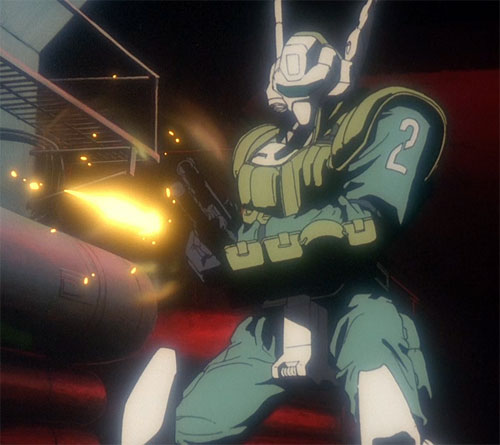
I had a great time watching the second Patlabor movie (1993). Although it bogged down in the middle and risked boring the audience it was a good movie overall and I would recommend it to mecha fans.
The story takes place about 3 years after the events of the first movie and the TV series. The plot was basically a copy of a 2 episode story from the first OAV story. I was happy to see this since that earlier story was good enough to deserve a more thorough treatment. Tsuge, a disgruntled member of the Japan Self Defense Force sees modern Japanese society as being too complacent. Tsuge feels the only way to make the Japanese people “wake up” is to destabilize the government and cause a panic. Captain Goto of Special Vehicles Section 2 sees the plot coming together and sends his team to stop Tsuge.

The animation quality was great. The character designs are again different from the first OAV and TV series. They look better than the first movie but it still would have been better to stick with the established look. Although mecha action was too small a part of this movie, what there was was great. With mecha designs by Izubuchi Yutaka, Kawamori Shoji and Katoki Hajime how can you lose?
Captain Goto seems to be the main character of this movie. Since he was always my favorite character that certainly made me happy. Although the rest of the characters of Special Vehicles Section 2 take a smaller role in this movie than they do in most other Patlabor anime, they still had more screen time and expressed their personalities more than in the first movie. It’s interesting to note that Kumagami Takeo wasn’t in the movie. I guess she wasn’t considered a core character. Like the first movie, we also get to see more of detective Matsui – another character I always liked.

The rebel group sends an attack helicopter to destroy the machines of Special Vehicles Section 2.
One of my minor disappointments of the movie was how, after three years, Goto had made no success in gaining the affections of Captain Nagumo. Isn’t three years long enough for someone as crafty as Goto to win her heart? At the end of the movie Goto seems to be giving up when he looks at his team of officers and says, “At least I’ll always have them.”
I think I finally understand what director Oshii Mamoru was trying to do with the first two Patlabor movies. Both movies have long scenes with no dialogue and ambient music that appear to encourage the audience to become introspective. I think what Oshii was trying to accomplish was to subtly tell the audience that the villains have a point. While the heroes are still heroes and the villains still need to be stopped, the villains do raise some points worth considering. The mad software programmer from the first movie and the disenchanted Defense Force fugitive are both upset with the effects of rapid economic and technological development on Japanese society. They feel the Japanese people have abandoned too much of what it means to be Japanese, and ignored the people of foreign nations, in order to pursue peace and prosperity.

The police labors are covered in a kind of bullet-proof armor that looks like clothes for giant robots.
This kind of social commentary isn’t found much in the OAVs or TV series. I thought that, while the attempts at a deeper discussion in the films was interesting, it wasn’t handled all that well. The first movie’s point that Japan was developing too quickly and the second movie’s point that Japan’s peace and prosperity were illusive and only possible at the expense of other nations’ happiness were both too simplistic and reactionary. If themes this deep are going to be discussed in a movie, they should be treated more intelligently. Other points of view and more information should be provided to better represent the issues. For example, a long discussion is placed in the middle of the second movie where both characters readily accept that Japan’s peace and economic success are the result of profitting off of foreign wars. But I don’t think this is true. I think if the armed conflicts in Africa, Southeast Asia and the Middle East were to stop Japan would still be prosperous (perhaps even more so).
On top of that, the long, introspective scenes in the movies intended to drive home the deeper messages were rather dull and probably caused a lot of viewers to wander off and never complete the movie. The “art house” feel isn’t for everyone.
Still, all things considered I enjoyed the movie and recommend that science-fiction fans check it out. Those of you who are mecha fans will probably shed a tear over all the cool mecha designs that only stand around in the movie. Just think how cool it could have been if there had been more action!







Hello there,
Good blog, I just found it and I am already a fan.